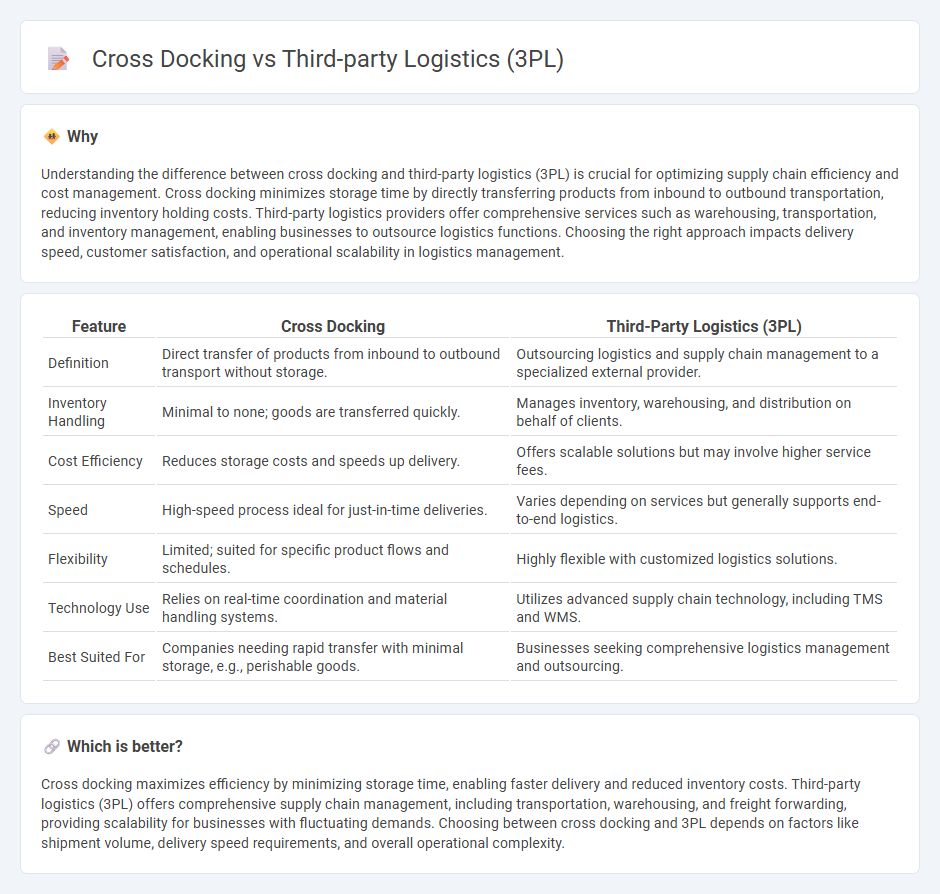
Cross docking streamlines supply chains by minimizing storage time and enabling rapid product transfer from inbound to outbound transportation. Third-party logistics (3PL) providers offer comprehensive supply chain solutions including warehousing, transportation, and inventory management, allowing businesses to outsource logistics operations effectively. Explore the advantages and applications of cross docking and 3PL to optimize your logistics strategy.
Why it is important
Understanding the difference between cross docking and third-party logistics (3PL) is crucial for optimizing supply chain efficiency and cost management. Cross docking minimizes storage time by directly transferring products from inbound to outbound transportation, reducing inventory holding costs. Third-party logistics providers offer comprehensive services such as warehousing, transportation, and inventory management, enabling businesses to outsource logistics functions. Choosing the right approach impacts delivery speed, customer satisfaction, and operational scalability in logistics management.
Comparison Table
| Feature | Cross Docking | Third-Party Logistics (3PL) |
|---|---|---|
| Definition | Direct transfer of products from inbound to outbound transport without storage. | Outsourcing logistics and supply chain management to a specialized external provider. |
| Inventory Handling | Minimal to none; goods are transferred quickly. | Manages inventory, warehousing, and distribution on behalf of clients. |
| Cost Efficiency | Reduces storage costs and speeds up delivery. | Offers scalable solutions but may involve higher service fees. |
| Speed | High-speed process ideal for just-in-time deliveries. | Varies depending on services but generally supports end-to-end logistics. |
| Flexibility | Limited; suited for specific product flows and schedules. | Highly flexible with customized logistics solutions. |
| Technology Use | Relies on real-time coordination and material handling systems. | Utilizes advanced supply chain technology, including TMS and WMS. |
| Best Suited For | Companies needing rapid transfer with minimal storage, e.g., perishable goods. | Businesses seeking comprehensive logistics management and outsourcing. |
Which is better?
Cross docking maximizes efficiency by minimizing storage time, enabling faster delivery and reduced inventory costs. Third-party logistics (3PL) offers comprehensive supply chain management, including transportation, warehousing, and freight forwarding, providing scalability for businesses with fluctuating demands. Choosing between cross docking and 3PL depends on factors like shipment volume, delivery speed requirements, and overall operational complexity.
Connection
Cross docking streamlines supply chain operations by minimizing storage time, a service often facilitated by third-party logistics (3PL) providers who specialize in efficient inventory transfer and distribution. 3PL companies integrate cross docking techniques to reduce transportation costs and improve delivery speed by directly transferring goods from inbound to outbound shipments. Leveraging advanced warehouse management systems, 3PL providers optimize cross docking processes to enhance inventory flow and meet customer demand dynamically.
Key Terms
Outsourcing
Third-party logistics (3PL) providers manage outsourced supply chain functions including warehousing, transportation, and inventory management to enhance efficiency and reduce costs. Cross docking is a logistics strategy used within the supply chain where products are directly transferred from inbound to outbound transportation with minimal or no storage, reducing handling time and storage costs. Explore how outsourcing through 3PL integrates cross docking to streamline operations and improve delivery speed.
Inventory Holding
Third-party logistics (3PL) providers manage comprehensive inventory storage and handling services, reducing the need for businesses to maintain large warehouse spaces. Cross docking minimizes inventory holding by transferring products directly from inbound to outbound transportation with minimal storage time, enhancing supply chain efficiency. Explore further to understand how inventory strategies differ between 3PL and cross docking for optimizing logistics operations.
Transit Time
Third-party logistics (3PL) providers often manage warehousing, transportation, and distribution to optimize overall transit times through integrated supply chain solutions. Cross docking minimizes transit time by directly transferring goods from inbound to outbound transportation without long-term storage, significantly reducing handling and storage delays. Explore the advantages and transit time impacts of both strategies to enhance your supply chain efficiency.
Source and External Links
What is 3PL (third-party logistics)? | Definition from TechTarget - A 3PL provider offers outsourced logistics services that manage aspects of procurement and fulfillment, including warehousing and transportation, enabling businesses to control shipping costs and focus on core operations by outsourcing order fulfillment and shipping.
What is a 3PL? Third-party logistics definition, process, and resources - A third-party logistics provider specializes in inventory management, warehousing, order fulfillment, shipping, and sometimes global logistics, allowing companies to streamline their supply chains and focus on growth by outsourcing logistics functions.
How 3PLs Revolutionize Logistics and Supply Chain Management - 3PLs are third-party companies that outsource supply chain management tasks such as transportation, warehousing, order fulfillment, and customs brokerage, helping businesses improve efficiency and scalability by leveraging specialized expertise and technology.
 dowidth.com
dowidth.com